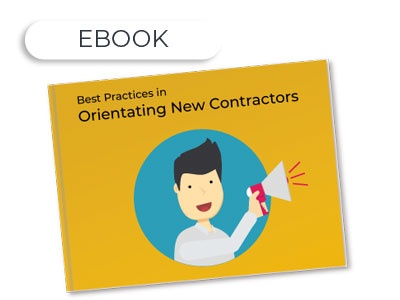- Applicable federal, state, or locally-mandated rules for safety
- Do’s and don’ts to observe on the job site
- Location of emergency exits
- Identification of the safety manager
- A tour of the site
Want to make sure you’re covering all the bases in your contractor orientations? Download our free guide, Best Practices In Orientating New Contractors.
Advantages Of Online Orientation Programs
There are a number of advantages to moving your orientations online:- Elimination of repeated—and repetitive—orientation sessions is the most obvious advantage.
- Knowing the workers who are onsite is simplified with online onboarding and orientation. At the beginning of any project or project phase, workers who show up at the site may be an unknown quantity to the general contractor. The company they are associated with, their level of training, and other details about the workers’ backgrounds are a mystery. When all that data is entered into the platform and the orientation is completed, the worker comes out on the other side of the process fully compliant; the contractor knows all of their data and can verify that they have received at least a minimal amount of training.
- Elimination of man-hours lost to traditional on-site orientations. If orientation takes two hours and 500 different workers cycle through the site, that amounts to a significant reduction in man-hours lost to training and a significant cost savings.
- Worker engagement with the training material is increased with online onboarding and orientation. Workers complete the tasks on their own time—and at their own pace. Instead of a training session where workers in the back of the room are looking at their phones or dozing, online training requires close attention. Why? Because participants must answer questions at the end before they can move on to the next chapter or module or receive clearance to work on the site. Workers can’t ask the guy sitting next to them the answers to the questions they missed because they weren’t paying attention. In addition, online orientation can include different elements for learning to cater to the worker’s particular learning style, whether it’s reading the material or watching and listening to a video.
- Managers can see at a glance if the worker coming onto the site is compliant. Online training allows project and safety managers who may be spread thin over several different job sites to verify that all workers have satisfactorily completed a minimum level of training to ensure compliance with regulations. Managers can easily verify that each worker has completed the contractor safety orientation to protect the individual’s safety on the job site—and to protect the safety of his or her co-workers.
- Eliminates the need to chase—or keep up with—paperwork. With software like GoContractor, all workers’ IDs, licenses, and certifications are stored in their online profiles. GoContractor’s online platform is capable of sending notifications when workers’ credentials are about to expire, and the workers, contractor, and project manager will be alerted so credentials are updated accordingly.
- Online orientations free up project and safety managers’ time for higher-value activities. Ultimately, spending several hours in front of a group of workers once or more per week is not the best use of a manager’s time. Allowing workers to complete orientations online frees up project and safety managers to supervise work on the job site and do spot safety checks to reduce the chance of accidents and protect worker safety.
GoContractor: Easy Setup For New Contractor Orientation OnlineGoContractor is an easy-to-use, end-to-end contractor management software for onboarding workers. Our software includes an easy to use online orientation tool. It’s so easy that you can build your site-specific online orientation system in as little as 20 minutes.
|
An Easy Win For Project Managers
Many construction software programs are complex, and can forget about the person who will ultimately be using the software most. GoContractor was built specifically for managers and construction workers. Our contractor orientation tool is straightforward and easy to use, making new contractor orientation software implementation an easy productivity gain. Using an online platform for onboarding and orientation can put several hours back into a project or safety manager’s day—which would otherwise be spent chasing paperwork or conducting repeated orientations for new workers arriving on site. Given the many advantages of online orientation and the GoContractor platform’s ease of use for both contractors and workers, moving your onboarding and orientation processes online may be the easiest opportunity available to contractors and project managers for boosting productivity and profitability—while also freeing up time for more valuable work.Wondering if there’s a better way to handle contractor orientation on your construction projects?
At GoContractor, our goal is to streamline project onboarding and worker orientation for contractors, saving time and money. Get in touch and let us show you how we can improve your onboarding and orientation processes to make your next project more profitable.